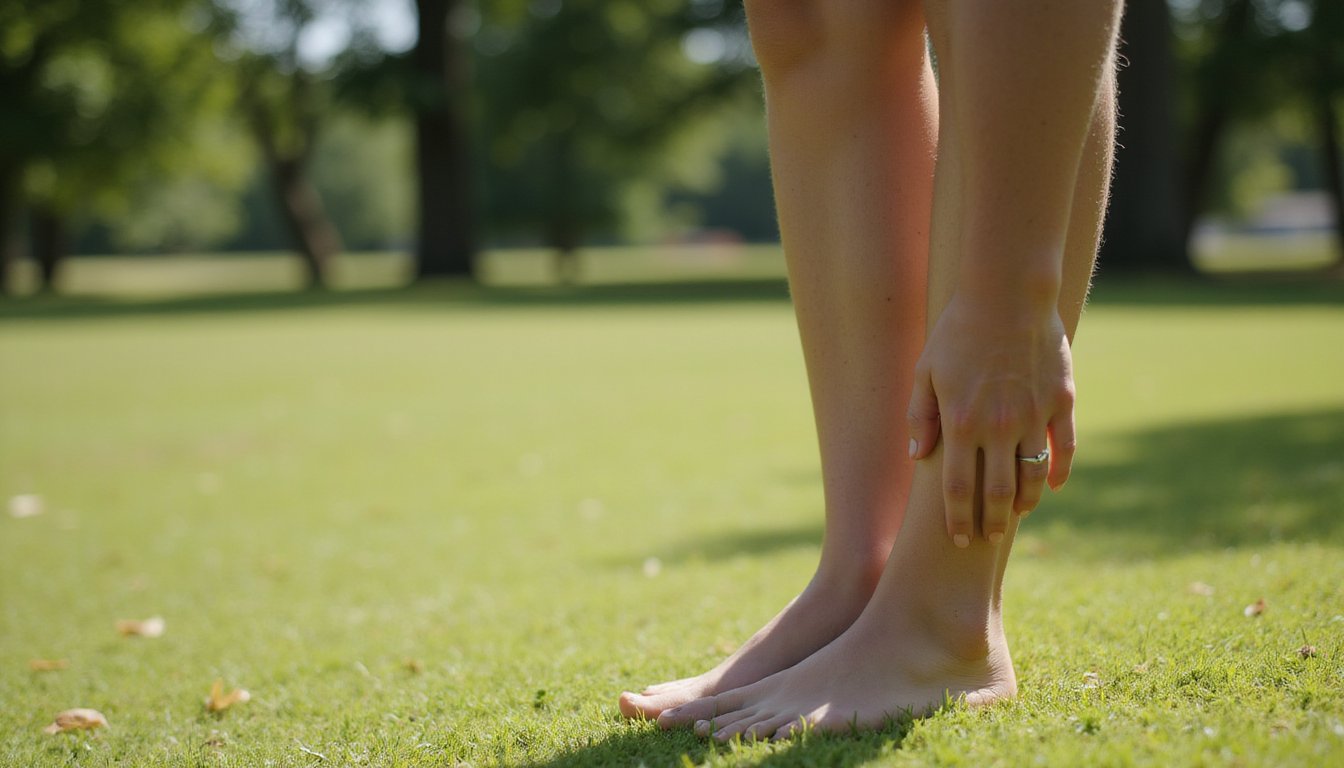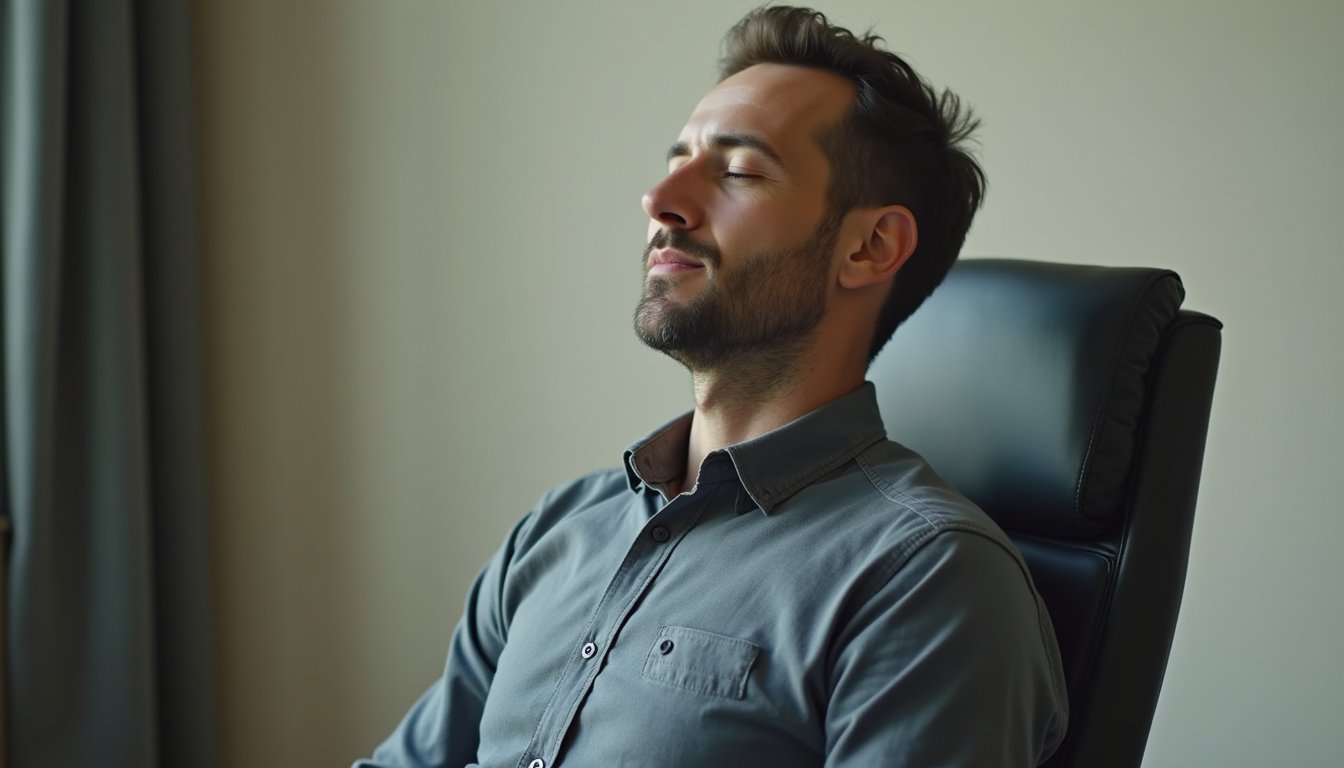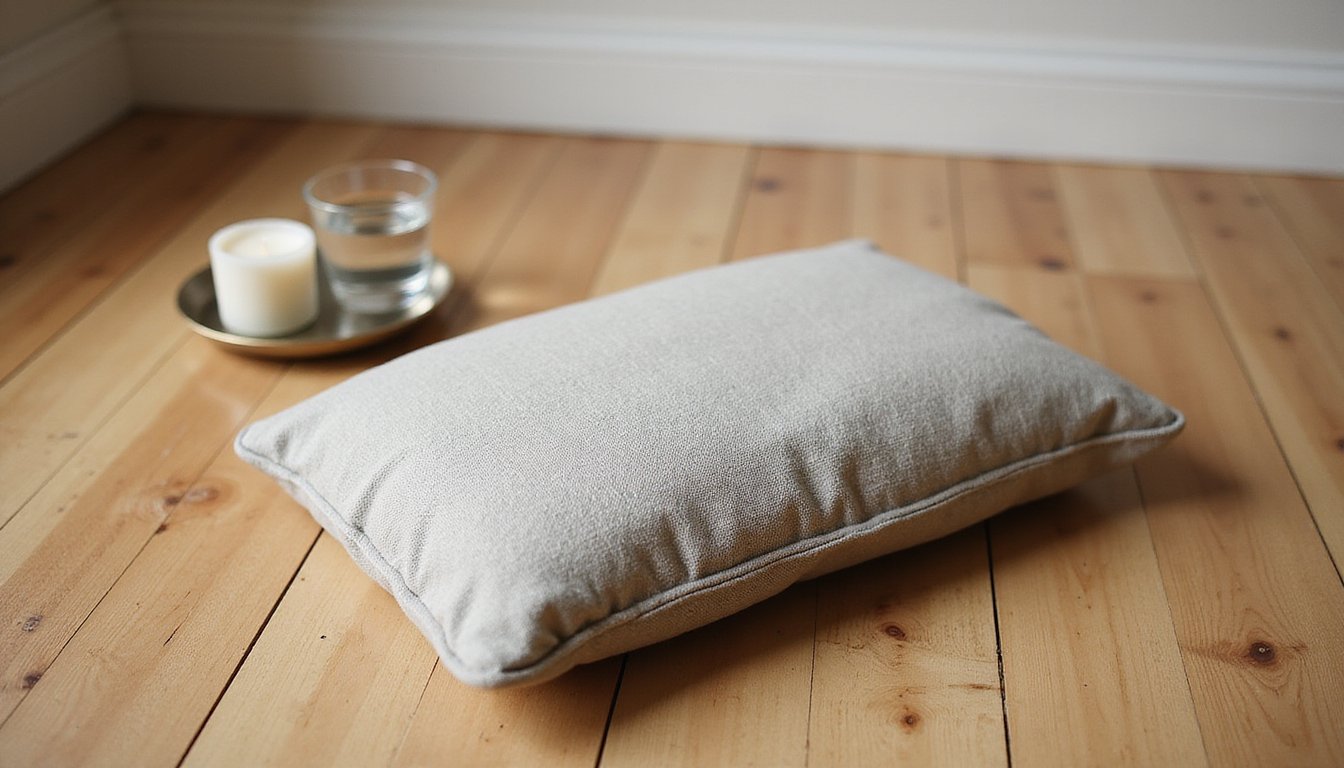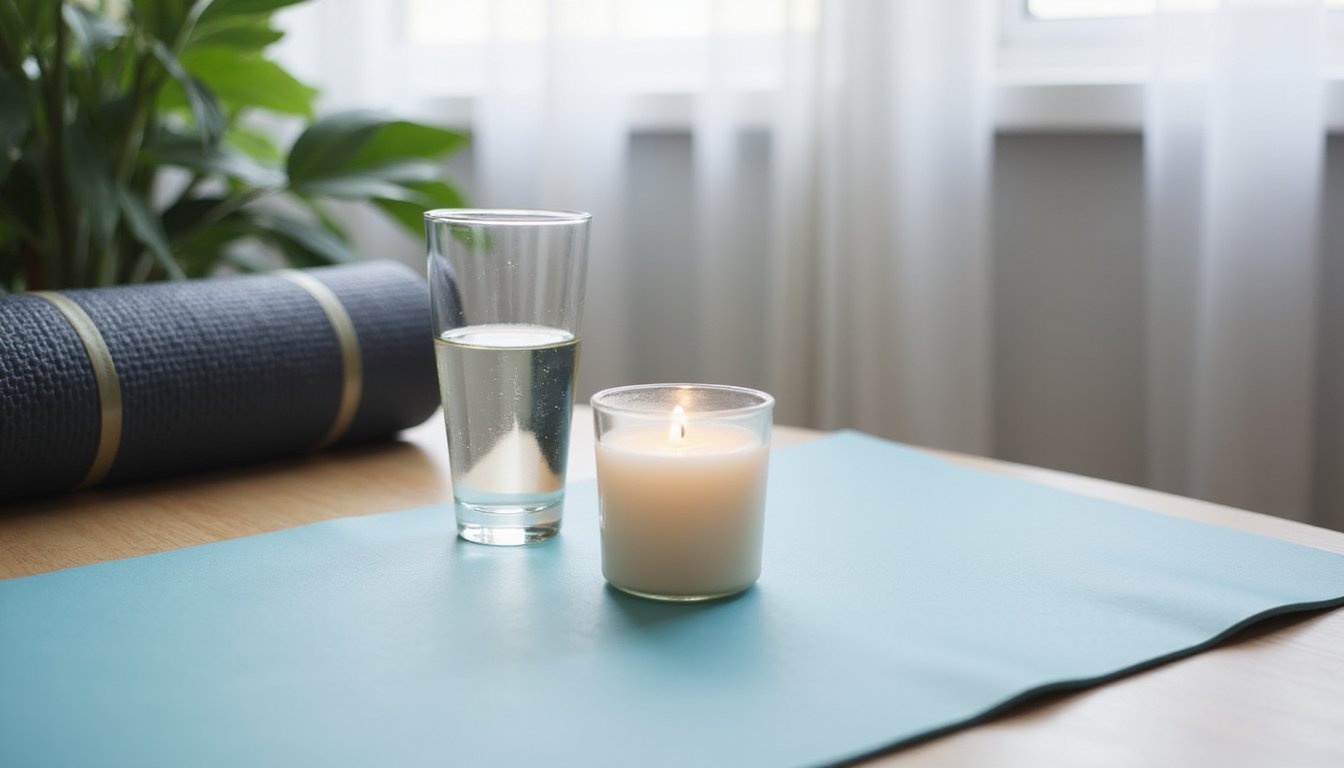Grounding techniques are scientifically proven to reduce anxiety symptoms through measurable physiological changes in your nervous system. When you practice methods like the 5-4-3-2-1 technique or controlled breathing exercises, you’ll trigger your body’s natural calming response, reducing muscle tension and improving heart rate variability. Research shows these practices can provide immediate relief comparable to traditional therapy, while being cost-effective and accessible. Understanding the science behind these techniques will help you optimize their anxiety-reducing benefits.
The Science Behind Grounding Techniques

How exactly do grounding techniques influence our biology to reduce anxiety? Research reveals multiple mechanisms at work. When you connect with the Earth’s surface, your body receives free electrons that promote bioelectrical regulation, stabilizing your nervous system and reducing stress responses.
These techniques trigger profound physiological changes. They modulate your autonomic nervous system, lowering muscle tension and improving heart rate variability. Through hormonal axis modulation, grounding reduces corticotrophin-releasing factor and affects corticosterone secretion, key factors in anxiety regulation. Recent studies found that placing rats on earthing mats for 21 days helped decrease stress-induced behavioral changes. The practice has been shown to enhance cognitive function in numerous studies. You’ll also experience decreased inflammation markers and improved blood viscosity. Using physical grounding techniques like clenching fists or stretching can provide immediate bodily relief from anxiety symptoms.
The process engages your sensory pathways, redirecting attention from anxious thoughts while activating the parasympathetic nervous system. This scientific foundation explains why grounding can effectively calm your body’s stress response and provide immediate anxiety relief.
Research-Backed Evidence for Anxiety Relief
While skeptics may question alternative anxiety treatments, extensive research confirms the effectiveness of grounding techniques across diverse populations and settings. Clinical studies show these methods reduce anxiety levels comparable to traditional therapy, with immediate symptom relief and measurable physiological benefits including lower blood pressure and improved heart rate variability. Present moment awareness helps people shift attention away from anxious thoughts to their immediate surroundings.
Movement-based grounding interventions have demonstrated success in emotional regulation and self-awareness through mindful body connection. You’ll find strong evidence supporting multiple approaches, from progressive muscle relaxation to controlled breathing exercises. These techniques effectively regulate your autonomic nervous system, decrease inflammation markers, and promote calmer brain wave patterns. What’s particularly compelling is how grounding addresses both accessibility barriers and cost-effectiveness concerns; you don’t need special equipment or professional supervision to benefit. Research demonstrates these interventions are safe, universally accessible, and provide lasting improvements in anxiety management, sleep quality, and cognitive function. Studies specifically highlight how cognitive defusion techniques can reduce the intrusiveness of anxious thoughts and decrease the intensity of mental imagery.
Common Types of Grounding Methods

When you’re experiencing anxiety, physical sensory anchoring techniques like the 5-4-3-2-1 method or touch-based grounding can quickly reconnect you with your immediate environment. You’ll find that actively engaging your senses through temperature changes, textured objects, or deliberate movement helps shift attention away from anxious thoughts to concrete, present-moment experiences. Progressive relaxation methods, including systematic muscle tension-release exercises and mindful breathing patterns, work to calm your nervous system while strengthening the connection between your mind and body. Gentle affirmations repeated regularly can help build mental resilience and provide reassurance during moments of distress. Practicing the 4-4-4 breathing technique, which involves inhaling, holding, and exhaling for equal counts, can effectively reduce heart rate and promote relaxation. Studies indicate that practicing yoga for six months can significantly reduce anxiety symptoms and promote overall emotional well-being.
Physical Sensory Anchoring Techniques
Five primary sensory anchoring techniques form the foundation of effective grounding practices for anxiety management. Through multi-sensory integration, you’ll engage with your environment using sight, touch, hearing, smell, and movement to regulate emotional responses effectively.
Visual anchoring involves identifying specific objects and their details, while tactile techniques encourage you to amplify textures and temperatures. Regular sensory practice helps improve overall mindfulness and emotional regulation over time. Research shows that everyday activities like drinking coffee or taking a shower can serve as powerful grounding exercises. You can practice auditory grounding by focusing on distinct environmental sounds, and employ olfactory and taste-based methods to create immediate sensory connections. Movement-based techniques activate your body’s proprioceptive awareness through simple actions like stretching or toe-wiggling.
Research demonstrates that these physical anchoring methods bolster emotional self-regulation and trigger parasympathetic responses, making them valuable tools for managing acute anxiety symptoms in any setting. The 5-4-3-2-1 technique has been shown to reduce anxiety symptoms in over two-thirds of people within just five minutes of practice.
Progressive Relaxation Methods
A toolkit of progressive relaxation methods offers proven pathways for managing anxiety through structured mental and physical techniques. Research shows these approaches effectively reduce both acute and chronic anxiety symptoms through somatosensory stimulation and controlled diaphragmatic breathing. Healthcare providers recommend these methods as complementary therapies for managing various stress-related conditions. Studies of nurse trainees confirm that stress responses decrease with regular practice.
| Technique | Benefits |
|---|---|
| Progressive Muscle Relaxation | Systematically releases physical tension through muscle control |
| Deep Breathing Exercises | Reduces heart rate and blood pressure through respiratory regulation |
| Guided Imagery | Promotes mental calm through structured visualization |
You’ll find these methods particularly effective because they engage both “top-down” cortical control and “bottom-up” proprioceptive feedback. Clinical studies demonstrate immediate physiological benefits, including decreased heart rate and reduced electrodermal activity. When practiced regularly, these techniques build lasting resilience against anxiety triggers while offering flexible delivery options through in-person guidance or digital platforms.
Physical Benefits and Body Response
Research shows that grounding techniques directly calm your nervous system by activating the parasympathetic response, which lowers your heart rate and blood pressure during anxiety episodes. Your muscle tension begins to decrease as you engage in physical grounding practices like pressing your feet to the floor or progressive muscle relaxation. When you combine these methods with controlled breathing, you’ll experience measurable reductions in physiological stress markers, including normalized cortisol levels and improved vagal tone. These practices are most effective when regularly practiced, helping to build lasting resilience and coping skills over time.
Calming Your Nervous System
Scientific evidence demonstrates that grounding techniques produce measurable physiological changes that calm your nervous system within minutes of practice. When you engage in grounding, you’ll shift from sympathetic (fight-or-flight) to parasympathetic (rest-and-digest) activation, promoting nervous system coherence and physiological resilience.
Research shows that 30 minutes of grounding substantially reduces cortisol levels while increasing heart rate variability, a key indicator of stress resilience. You’ll experience improved autonomic balance, marked by a slower heart rate and augmented calmness. These changes aren’t just subjective; they’re quantifiable through decreased inflammatory markers and increased alpha brain wave patterns. Your brain’s electrical activity becomes more coherent with the earth’s natural frequency, supporting emotional regulation and mental clarity. This physiological recalibration helps normalize your sleep-wake cycle and stabilize your body’s stress response.
Muscle Tension Reduction
Physical evidence consistently demonstrates that grounding techniques deliver immediate and measurable reductions in muscle tension throughout your body. When you practice progressive muscle relaxation (PMR) or outdoor grounding, you’ll experience significant decreases in muscular tightness and associated pain. These techniques work by activating your parasympathetic nervous system while reducing inflammation markers linked to chronic tension.
Beyond minimizing muscle fatigue, grounding’s muscle strengthening benefits include amplified flexibility and improved joint mobility. You’ll find that regular practice helps you identify and release areas of tension more quickly, particularly when combined with stretching or therapeutic exercise. Whether you’re dealing with anxiety-related muscle tension or post-exercise soreness, grounding techniques provide both immediate relief and cumulative benefits, especially when performed in natural environments with direct earth contact.
Heart Rate Benefits
The profound impact of grounding techniques on heart rate regulation offers immediate and lasting benefits for anxiety management. When you practice grounding, you’ll activate your parasympathetic nervous system, which effectively counters the heightened heart rate typically associated with anxiety.
Studies show that grounding exercises directly influence cardiovascular outcomes through multiple pathways. You’ll experience improved heart rate variability, indicating better stress resilience and emotional regulation. The techniques work by shifting your body from a “fight or flight” state to a calmer “rest and digest” mode, reducing adrenaline and cortisol release. This results in measurable decreases in your resting heart rate and fewer anxiety-related symptoms like palpitations and chest tightness. With regular practice, you’ll develop augmented autonomic flexibility, supporting long-term heart health and sustained anxiety relief.
Who Can Benefit From Grounding Practices
Grounding practices offer documented benefits across numerous populations, from individuals with clinical anxiety disorders to everyday stress managers. Research demonstrates effectiveness among diverse populations, with clinical integration showing particular promise for trauma survivors and those with PTSD.
You’ll find these techniques especially beneficial if you’re among:
- Those experiencing anxiety disorders, with studies showing significant symptom reduction across 284 million affected globally
- Trauma survivors managing flashbacks or dissociative symptoms, which affect over 61% of U.S. adults
- Individuals dealing with somatoform disorders or daily stress management needs
Children, adolescents, and neurodiverse individuals can also benefit from adapted grounding methods. The evidence supports applications in both clinical and everyday settings, making these practices versatile tools for emotional regulation and stress management.
Step-by-Step Guide to Getting Started

Starting your path with grounding techniques requires a systematic approach backed by clinical evidence. Begin by selecting a calm environment and removing distractions like mobile devices. You’ll find better results by adopting a comfortable posture, whether sitting or standing.
Choose one technique to master initially; the 5-4-3-2-1 method offers an exhaustive sensory approach, while the 3-3-3 technique provides quick relief. Practice your chosen method daily, maintaining consistency even when you’re not experiencing anxiety. Monitor your physiological responses and track outcomes in a log to assess effectiveness.
Building long-term skills means integrating these practices into your daily routine. Start with brief 2-minute sessions, gradually extending length as needed. Remember to adjust techniques if they’re not providing sufficient relief, and consider combining them with professional support for boosted benefits.
Best Practices for Maximum Effectiveness
While maximizing the benefits of grounding techniques requires careful attention to several key factors, research demonstrates that proper implementation yields significant physiological and psychological improvements. To achieve ideal results, you’ll need to maintain consistency in practice while monitoring progress over time through systematic documentation.
For sustained anxiety relief, focus on these evidence-based recommendations:
- Practice regularly at set times, incorporating digital tools to track your physiological responses and engagement patterns
- Customize techniques based on your sensory preferences, whether visual, auditory, or tactile, to improve effectiveness
- Combine multiple approaches, such as progressive muscle relaxation with deep breathing, to activate extensive stress-reduction pathways
Remember to adjust your practice intensity and duration based on measured outcomes, allowing for flexibility while maintaining structured implementation.
Real-World Success Stories
Through countless documented cases and clinical testimonials, real-world applications of grounding techniques have demonstrated remarkable success in managing acute and chronic anxiety. These accessible interventions have proven effective across diverse demographics, from adolescents to older adults, regardless of cultural background or specific anxiety disorder type.
| Setting | Reported Benefits |
|---|---|
| Workplace | Improved stress management and performance |
| Schools | Better test anxiety control and focus |
| Public Spaces | Amplified social interaction confidence |
| Clinical Settings | Successful trauma processing and therapy engagement |
You’ll find that consistent practice leads to lasting benefits, including lower baseline anxiety levels and increased emotional resilience. Whether you’re managing panic attacks, social anxiety, or PTSD, grounding techniques offer portable, adaptable solutions that you can implement immediately in any environment.
Expert Recommendations and Tips
You’ll gain the most benefit from grounding techniques by practicing them regularly during calm periods, rather than waiting until you’re in crisis. While these methods can effectively manage mild to moderate anxiety symptoms, persistent severe anxiety requires professional evaluation and treatment. Contact a mental health provider if your anxiety drastically impacts daily functioning, causes physical symptoms, or doesn’t improve with consistent grounding practice.
Best Practice Implementation Tips
Implementing grounding techniques effectively requires a strategic approach that combines personalization, consistent practice, and evidence-based methods. When customizing grounding techniques, you’ll want to select methods that align with your sensory preferences and lifestyle needs, adapting grounding practices to work in ideal environments.
For prime results, follow these essential steps:
- Start with brief, frequent practice sessions rather than extended periods
- Track your anxiety levels and technique effectiveness regularly
- Combine physical and sensory methods like the 5-4-3-2-1 technique with controlled breathing
You’ll achieve the best outcomes by practicing during calm periods, which strengthens your ability to use these techniques during heightened anxiety. Remember to adjust the intensity and sequence of sensory cues based on your response and specific context.
When To Contact Professionals
While grounding techniques offer valuable self-management tools for anxiety, recognizing when to seek professional help marks a critical boundary in mental health care.
You should contact a mental health professional if you’re experiencing anxiety symptoms that persist for six months or longer, considerably impair your daily functioning, or lead to chronic physical symptoms like recurring headaches and unexplained muscle pain. Watch for warning signs such as frequent catastrophizing, hypervigilance, or using avoidance behaviors that interfere with work, relationships, or social activities.
Seek immediate emergency care if you’re having thoughts of self-harm, experiencing severe anxiety attacks that affect your ability to function, or developing symptoms that make you feel unsafe. Remember, recognizing clinical severity early enables more effective intervention and better outcomes.
Long-Term Effects and Ongoing Research
The long-term effectiveness of grounding techniques presents a complex picture in current research. While you’ll experience immediate relief from anxiety symptoms, the durability of these cognitive effects requires ongoing practice and engagement for sustained emotional stability.
Grounding techniques offer quick anxiety relief, but maintaining long-term benefits depends on dedicated, consistent practice over time.
Current research highlights three key findings about long-term outcomes:
- Regular practice may help form lasting anxiety-management habits
- Mindfulness-based grounding shows the most consistent long-term benefits
- Effects tend to diminish when practice stops, suggesting maintenance is vital
Studies show that combining grounding with traditional therapy produces comparable results to standalone treatments. However, researchers still need to conduct more extensive longitudinal studies to fully understand the sustained benefits. Your best approach is maintaining consistent practice while working with healthcare providers to monitor and adjust techniques for ideal results.
Frequently Asked Questions
Can Grounding Techniques Interfere With Existing Anxiety Medications?
You don’t need to worry about medication interactions between grounding techniques and your anxiety medications. Current clinical evidence shows grounding practices won’t interfere with SSRIs, benzodiazepines, or other anxiety medications. No dosage considerations are required when adding grounding to your treatment plan. Since grounding works as a complementary psychological tool rather than a biochemical agent, it’s considered safe to practice alongside your prescribed medications without reducing their effectiveness.
How Long Does Anxiety Relief Last After Using Grounding Methods?
You’ll typically experience immediate relaxation when using grounding techniques, but the effects are temporary. The relief usually lasts anywhere from several minutes up to an hour after your session. The duration depends on your individual response, the type of technique you’re using, and your anxiety’s initial intensity. To extend these benefits, you’ll need to practice regularly and potentially combine grounding with other coping strategies or therapeutic approaches.
Are Grounding Techniques Safe During Pregnancy?
Yes, you can safely practice grounding techniques during pregnancy when done appropriately. Walking barefoot on natural surfaces and using grounding mats are generally safe methods that may help reduce your increased stress levels. While there’s no evidence that grounding affects fetal heart rate monitoring, you should consult your healthcare provider before starting, especially if you have pregnancy complications or medical conditions. Avoid adhesive grounding patches and chemically-treated surfaces during pregnancy.
Should Grounding Exercises Be Practiced Daily Even Without Anxiety Symptoms?
Yes, you’ll benefit from practicing grounding exercises daily, even when you’re feeling calm. Regular practice strengthens your nervous system’s resilience and makes these techniques more effective when you do experience anxiety. You’ll gain ongoing mindfulness benefits like improved sleep quality, better emotional regulation, and augmented stress management capacity. Think of it as building emotional fitness, just as you wouldn’t wait until you’re sick to exercise, don’t wait for anxiety to practice grounding.
Can Children Effectively Learn and Use Grounding Techniques?
Yes, children can effectively learn and use grounding techniques when taught through developmentally-appropriate activities and with consistent caregiver involvement. You’ll find that children respond well to sensory-based exercises like the 5-4-3-2-1 technique and physical activities such as hand tracing. Research shows these methods reduce anxiety symptoms in pediatric populations, with moderate effect sizes. For best results, you’ll want to practice these techniques during calm periods and customize them to your child’s stage of growth.





